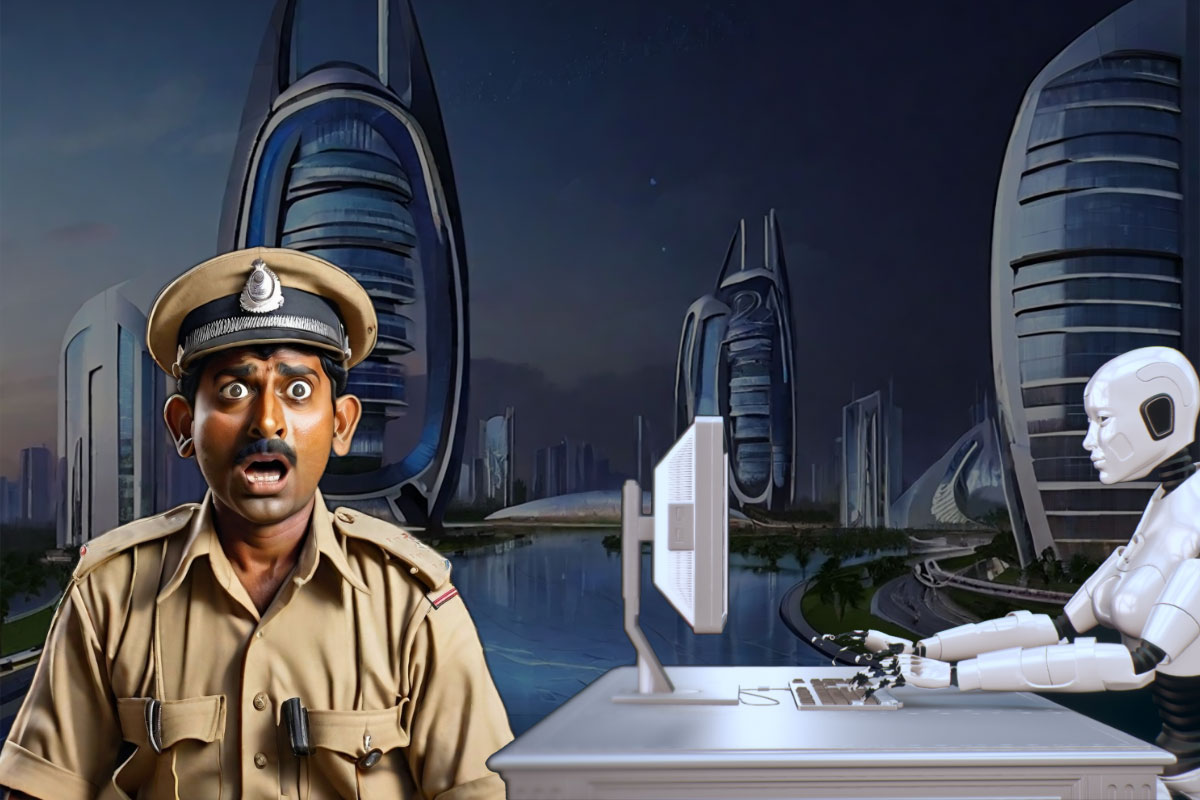Devastating statistics of fatal crashes at intersections managed by both police personnel and traffic lights in India call for action. An unexpected solution comes from the tech industry. What if I tell you that ITMS “smart” city tech can save thousands of lives each year? Incredible, isn’t it? Now, let’s dive into more details.

A staggering number of deaths in car crashes were registered in India in 2022. To be precise, 2,421 people died in fatal accidents at police-regulated intersections. This number is higher by almost 200 compared to those road crossings where traffic signals perform traffic management. A further 7,733 people were injured at those intersections where the police are supposed to control the traffic situation. Another alarming fact is that the death statistics at regulated crossroads show a +400 surge compared to 2021.
If these numbers seem high, you will be shocked at how many people die at unregulated intersections. In 2022, there were 24,857 casualties and 68,833 people injured in crashes at “uncontrolled crossings” without any traffic signals or policemen in sight.
Overall, India saw a 9.4% increase in fatalities due to road accidents in 2022, while the total number of accidents went up by 11.9%. Furthermore, India has the highest number of road accident fatalities globally, with around 1.5 million lives lost every year.
It is obvious that the road safety conditions in India need immediate improvement. What can be done? One possible solution comes from the realm of advanced technologies. It is called the Intelligent Traffic Management System (ITMS).
ITMS in a Nutshell
Traffic management is of crucial importance to any city or region that strives to become safer and improve the well-being of its citizens. “Smart” technologies like artificial intelligence (AI) and Internet of Things (IoT) are implemented in intelligent traffic management systems that make separate traffic control elements interconnected and highly efficient.
ITMS provides real-time data on traffic conditions, forecasting potential traffic jams and bottlenecks, and adjusting traffic signals and signs automatically to optimise traffic flow. Besides, the integrated alert system may timely signal the authorities about any incidents or critical road conditions, enabling road services or the police to respond more quickly.
Such “smart” systems are able to reduce congestion as well as connected air pollution, improve commuting time, increase road safety, automate the fixation of traffic-rules violations, speed up the emergency services’ reactions to accidents, adjust traffic signal timings to a real-time road situation.
Typically, ITMS consists of adaptive traffic signal controls, photoelectric sensors, AI-enabled real-time data analysers, machine learning (ML) technology, vehicle speed detection systems, automatic number-plate recognition (ANPR), red-light-violation detection cameras and radars, axle weight pads, and other related soft- and hardware.
As the technology evolves, ITMS can and probably should be integrated with various fintech solutions. One of the obvious use cases already present is automatic notifications about fines for parking and driving violations, along with the seamless challan payments through India’s e-challan system. Since ITMS can potentially access vehicles’ GPS data, and integrates well with various IoT systems, it can be also used to facilitate parking and fuel payment systems.
Is There ITMS in India?
The government of India acknowledged the need for making cities nationwide smarter about a decade ago. Therefore, the Ministry of Housing and Urban Affairs of the Government of India launched the Smart Cities Mission (SCM) in 2015 with the aim to develop 100 cities in India as Smart Cities. This involves smart traffic management, among other aspects.
As of late 2021, cities selected under the Smart Cities Mission have tendered out a total of 6,452 projects worth ₹1,84,998 crore. At the same time, ITMS currently present in the Indian market still has many limitations. Many private and public institutions working towards ITMS perfection, keep developing innovative tech solutions that can be applied in local smart systems and solve the existing issues before scaling up.
To be frank, ITMS technology in India is in its nascent stage. Nevertheless, the country does have a few good examples of ITMS practical implementation.
Vehant Technologies ISMT in Hyderabad, Lucknow, and 30+ more cities
ISMT designed by Vehant Technologies combines the capabilities of AI/ML, surveillance, traffic monitoring, and junction enforcement solutions.
It detects various violations such as red-light jumping, over-speeding, no helmet riding, triple riding, wrong lane movement, and more in real-time 24/7. With the latest AI developments, ISMT can not only automatically read the number plate, but also define the vehicle’s colour, make and other details. The advanced cameras analyse the picture of the driver to detect the absence of a seat belt or using the phone while driving. That is an important improvement for tackling road safety issues.
The solution also allows traffic police to keep track of violators and generate an e-challan along with photo or video evidence sent to the violators’ mobile phones via SMS. Therefore, the company closely cooperates with the traffic police departments of Hyderabad, Cyberabad, Rajasthan, Mumbai, Kerala, Pune, Punjab, Surat, and Bangalore.
Vehant Technologies has deployed cameras at more than 10,000 lanes in 42 smart cities across India and introduced a real-time 4D imaging radar-based system TrafficMon to detect the spot, driving direction, and average speed of any vehicle including even two-wheelers.
Smart City Ahmedabad
Being one of the country’s fast-growing industrial hubs, Ahmedabad got its public transportation system upgraded with the latest technology – IoT and big data analysis – in 2017. The partnership between Smart City Ahmedabad Development Limited (SCADL) and NEC enabled the building of a smart bus system in the city.
The legacy manually operated system had a number of drawbacks ranging from poor route planning, to inefficient bus schedules, bus bunching, excessive waiting time, stop skipping, inconsistent cash collection, lack of transparency, and higher operating costs.
The introduction of ITMS made bus servicing easier, enabled cashless payments via prepaid RuPay card or smartphone, reduced problem-response time and lowered operating expenses.
Besides keeping track of the bus maintenance, fuel, and personnel routines, the smart system collects and analyses data to help optimise resources, and boost ticket sales.
Passengers now can see real-time bus information via mobile app, website and in-station boards. That helps them better plan their route and estimate waiting and arrival times.
Bus routes and schedules of Ahmedabad’s two major bus services Bus Rapid Transit (BRT) and city bus AMTS are optimised by data-driven analysis of bus travel performance and traffic volume. Besides, in-built incident management systems enable operators of the general command centre to track incidents such as equipment failure and bus accidents throughout the incident lifecycle and promptly react.
“This software-based system enables us to remunerate service contractors using concrete parameters such as total kilometres driven, driver behaviour, safe driving, route adherence. New scheduling systems are already generating sizable monthly savings.”
Rakesh Shankar, SCADL CEO
Inspired by the success of the ITMS system for buses, SCADL is now considering developing multimodal travel services uniting BRT, metro, railway, monorail, taxis, and other transport means in a seamless multi-channel service supported by integrated operation and ticketing platforms.
Pune Smart City
In mid-2023, Pune Smart City Development Corporation Limited completed the first phase of installing the Adaptive Traffic Management System (ATMS) components around the city. The new traffic system will use real-time data to analyse the traffic situation and synchronise the traffic signals at junctions where the system is installed.
At the initial stage, 30 signals with smart traffic system support were added to the city’s landscape. Next, the installation of ATMS equipment expanded to cover 95 more traffic junctions. Finally, the project aims to be extended to cover all 261 junctions across Pune in the second phase.
The ITMS that is nearing the final implementation stages consists of adaptive traffic controllers at junctions, connected traffic lights, traffic sensors, travel time devices, variable message sign boards and a video wall to monitor the sensors and cameras across the city. All the data-gathering devices will be integrated with the command control centre to manage the traffic signals and optimise road situation in the city.
Delhi Next in Line for ITMS
After an intensive study of the city’s 800+ conjunctions, it was announced that Delhi is set to have an ITMS by the end of 2024.
The commissioned survey analysed traffic volume, average road speed, pedestrian movement, stoppage time, accident hotspots, and average travel time at Delhi junctions. Delhi Traffic Police has also conducted a survey to identify 117 key points in the city where heavy traffic congestion occurs. This information will help wisely integrate the elements of ITMS to better perform its planned functions.
Delhi’s smart traffic management system was primarily designed to reduce congestion and enable faster and smarter vehicular movement, especially when it comes to emergency vehicles. It is supposed to automatically provide green lights for ambulances or fire engines and modify the signals of all the linked traffic lights.
Additionally, the ITMS will alert motorists about congestion, as well as parking slots available in all the civic-body-run parking lots around the city. Besides, the municipal authorities are cooperating with insurance companies to include pending traffic violation challans data in vehicle insurance protocols and leverage ITMS for enforcing e-challan.
Mumbai to Use ITMS to Bring Order to Its Chaotic Roads
This May, Mumbai was reported to be installing 550 innovative tech-laden traffic signals with LED lights, countdown timers, and real-time monitoring systems to enhance traffic efficiency.
The talks of equipping the busy Indian metropolis with ITMS have taken place for a few years now. However, the ITMS project is still not finalised. Moreover, after finishing with the theoretical part, the city might need 20+ months to implement it in practice.
It is expected that the city traffic police will be able to use a smart system to modify traffic signal timings according to real-time road situations. The authorities also plan to integrate it with the e-challan system to better enforce the fine payments.
Like in other cities of India, the main Mumbai transportation problems include heavy congestion, rules violation and evading penalties. All these factors naturally lead to traffic accidents, many of them deadly.
Current estimates suggest that over 400 motorised vehicles are added to Mumbai’s streets every day, only aggravating the traffic congestion and traffic management task.
How ITMS Can Help India Decrease Road Accident Fatalities: Summary
India’s ambitious plan of making its cities smart has ITMS at its core. Dangerous road junctions and inefficient traffic management are among the most pressing issues of Indian urban areas. Using smart technologies like AI/ML, radar-based tracking, Adaptive Traffic Management System (ATMS), vehicle identification systems, and integration with e-challan, ITMS can optimise signal timing, detect and fine the violators, and provide data-driven insights for better traffic and transport schedule planning. Most importantly, ITMS can save lives, with estimated diminishing of traffic conditions leading to potential accidents by up to 25%.









